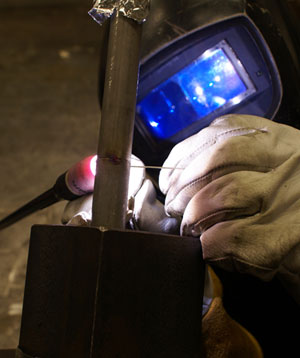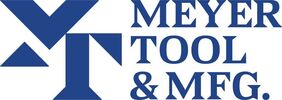Call: 708-425-9080
Qualifying Meyer Tool Welders for Aerospace Applications
 Precision Welding
Precision Welding
Recently Meyer Tool was engaged by a new customer in the aerospace industry to fabricate complex aluminum weldments. Meyer Tool welders and weld procedures are qualified to ASME Section IX. For this project we were required to qualify our welders to AWS D17.1 Specification for Fusion Welding for Aerospace Applications.
The welding to be performed for this project consists primarily of Class A welds as defined by D17.1. Class A welds are for flight hardware and require the highest level of nondestructive examination (NDE) required by D17.1. These welds are all full penetration groove welds. The NDE requirement includes visual examination by a Certified Weld Inspector, penetrant examination (fluorescent as specified by the customer), and 100% radiographic examination. Our customer also specified a macro-examination coupon be prepared from the Procedure Qualification Record (PQR) weld coupon.
Meyer Tool has a number of existing Weld Procedure Specifications (WPS) for welding aluminum using the alternating current and direct current Gas Tungsten Arc Welding processes (GTAW-AC and GTAW-DC) as well as the direct current gas metal arc welding process (GMAW-DC). However D17.1 requirements for the WPS, PQR, and Welder Qualification Record (WQR), though similar to ASME IX, were sufficiently different for us to decide to generate a new WPS document to be supported by the new PQR.
Based on the parameters of the aluminum weldments being fabricated, we chose to base both our PQR coupon and welder qualification coupon on the welding of a 6” OD x 0.125” w Tube, with a circumferential butt groove weld with compete joint penetration, in the 1G (horizontal rolled position), using the AC GTAW process. Per D17.1, this coupon would qualify the WPS and the welders for thicknesses from 0.67t to 4t, “t” being the .125” thickness of the weld coupon. Because the welders qualified in the 1G position they would be limited to this for any production welding. Luckily, this position is both advantageous for achieving aluminum full penetration circumferential butt welds (girth welds) and our fabrication plan for the actual weldments called for welding in this position only.
We selected the AC GTAW process based on our many years of experience welding aluminum ASME U stamped pressure vessels, ultra-high vacuum vessels, and B31.3 process piping. This process has advantages over the direct current process as the reversal of current in the arc provides for cleaning and removal of the oxide film can often prevent a good aluminum weld.
The key weld parameters for the PQR and WQR were all prepared in advance with selection of the proper details for:
All three Meyer Tool welders who generated test coupons passed all NDE examinations (visual, liquid penetrant, and 100% radiography) on their first and only coupons.
Key to consistently achieving full penetration aluminum welds which will pass a 100% radiographic examination relies both on the experience and skill of Meyer Tool’s welders and our proper preparation of the weld parameters and the joints to be welded. At Meyer Tool, our skill and knowledge supports our promise to Reduce Project Risk to achieve the lowest total cost of ownership.
The welding to be performed for this project consists primarily of Class A welds as defined by D17.1. Class A welds are for flight hardware and require the highest level of nondestructive examination (NDE) required by D17.1. These welds are all full penetration groove welds. The NDE requirement includes visual examination by a Certified Weld Inspector, penetrant examination (fluorescent as specified by the customer), and 100% radiographic examination. Our customer also specified a macro-examination coupon be prepared from the Procedure Qualification Record (PQR) weld coupon.
Meyer Tool has a number of existing Weld Procedure Specifications (WPS) for welding aluminum using the alternating current and direct current Gas Tungsten Arc Welding processes (GTAW-AC and GTAW-DC) as well as the direct current gas metal arc welding process (GMAW-DC). However D17.1 requirements for the WPS, PQR, and Welder Qualification Record (WQR), though similar to ASME IX, were sufficiently different for us to decide to generate a new WPS document to be supported by the new PQR.
Based on the parameters of the aluminum weldments being fabricated, we chose to base both our PQR coupon and welder qualification coupon on the welding of a 6” OD x 0.125” w Tube, with a circumferential butt groove weld with compete joint penetration, in the 1G (horizontal rolled position), using the AC GTAW process. Per D17.1, this coupon would qualify the WPS and the welders for thicknesses from 0.67t to 4t, “t” being the .125” thickness of the weld coupon. Because the welders qualified in the 1G position they would be limited to this for any production welding. Luckily, this position is both advantageous for achieving aluminum full penetration circumferential butt welds (girth welds) and our fabrication plan for the actual weldments called for welding in this position only.
We selected the AC GTAW process based on our many years of experience welding aluminum ASME U stamped pressure vessels, ultra-high vacuum vessels, and B31.3 process piping. This process has advantages over the direct current process as the reversal of current in the arc provides for cleaning and removal of the oxide film can often prevent a good aluminum weld.
The key weld parameters for the PQR and WQR were all prepared in advance with selection of the proper details for:
- Coupon material (6061T6 Aluminum) diameter and thickness.
- Weld filler metal and diameter.
- Tungsten type and diameter.
- Orifice cut size.
- Shield gas composition and flow rate.
- Amperage range.
- Speed of travel for the weld manipulator.
- The number of expected passes.
- Weld preparation details.
All three Meyer Tool welders who generated test coupons passed all NDE examinations (visual, liquid penetrant, and 100% radiography) on their first and only coupons.
Key to consistently achieving full penetration aluminum welds which will pass a 100% radiographic examination relies both on the experience and skill of Meyer Tool’s welders and our proper preparation of the weld parameters and the joints to be welded. At Meyer Tool, our skill and knowledge supports our promise to Reduce Project Risk to achieve the lowest total cost of ownership.



